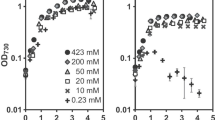Abstract
Inorganic-carbon transport was investigated in the eukaryotic marine microalgaeStichococcus minor, Nannochloropsis oculata and aMonallantus sp. Photosynthetic O2 evolution at constant inorganic-carbon concentration but varying pH showed thatS. minor had a greater capacity for CO2 rather than HCO −3 utilization but forN. oculata andMonallantus HCO −3 was the preferred source of inorganic carbon. All three microalgae had a low affinity for CO2 as shown by the measurement of inorganic-carbon-dependent photosynthetic O2 evolution at pH 5.0. At pH 8.3, where HCO −3 is the predominant form of inorganic carbon, the concentration of inorganic carbon required for half-maximal rate of photosynthetic O2 evolution [K 0.5 (CO2)] was 53 μM forMonallantus sp. and 125 μM forN. oculata, values compatible with HCO −3 transport. Neither extra- nor intracellular carbonic anhydrase was detected in these three microalgal species. It is concluded that these microalgae lack a specific transport system for CO2 but that HCO −3 transport occurs inN. oculata andMonallantus, and in the absence of intracellular carbonic anhydrase the conversion of HCO −3 to CO2 may be facilitated by the internal pH of the cell.
Similar content being viewed by others
References
Badger, M.R., Kaplan, A., Berry, J.A. (1980) Internal inorganic carbon pool ofChlamydomonas reinhardtii. Evidence for a carbon dioxide concentrating mechanism. Plant Physiol.66, 407–443
Beardall, J., Raven, J.A. (1981) Transport of inorganic carbon and the “CO2 concentrating mechanism” inChlorella emersonii (Chlorophyceae). J. Phycol.17, 134–141
Berry, J.A., Boynton, J., Kaplan, A., Badger, M.R. (1976) Growth and photosynthesis ofChlamydomonas reinhardtii as a function of CO2 concentration. Carnegie Inst. Washington Yearb.75, 423–433
Coleman, J.R., Berry, J.A., Togasaki, R.K., Grossman, R.A. (1984) Identification of extracellular carbonic anhydrase ofChlamydomonas reinhardtii. Plant Physiol.76, 472–477
Colman, B., Gehl, K.A. (1983) Physiological characteristics of photosynthesis inPorphyridium cruentum: evidence for bicarbonate transport in a unicellular red alga. J. Phycol.19, 216–219
Cook, C.M., Lanaras, T., Colman, B. (1986) Evidence for bicarbonate transport in species of Red and Brown macrophytic marine algae. J. Exp. Bot.180, 977–984
Dixon, G.K., Merrett, M.J. (1988) Bicarbonate utilization by the marine diatomPhaeodactylum tricornutum Bohlin. New Phytol.109, 47–51
Dixon, G.K., Patel, B.N., Merrett, M.J. (1987) Role of intracellular carbonic anhydrase in inorganic-carbon assimilation byPorphyridium purpureum. Planta172, 508–513
Dixon, G.K., Brownlee, C., Merrett, M.J. (1989) Measurement of internal pH in the coccolithophoreEmiliania huxleyi using 2′,7′-bis-(2-carboxyethyl)-5(and-6)carboxyfluorescein acetoxymethylester and digital imaging microscopy. Planta178, 443–449
Findenegg, G.R. (1976) Correlations between the accessibility of carbonic anhydrase for external substrate and regulation of photosynthetic use of CO2 and HCO −3 byScenedesmus obliquus. Z. Pflanzenphysiol.79, 428–437
Haldane, J.B.S., Stern, K.G. (1932) Allgemeine Chemie der Enzyme. Steinkopff Verlag, Dresden Leipzig
Hartree, E.F. (1972) A modification of the Lowry method that gives a linear photometric response. Anal. Biochem.48, 422–427
Hogetsu, D., Miyachi, S. (1977) Effects of CO2 concentration during growth on subsequent photosynthetic CO2 fixation inChlorella. Plant Cell Physiol.18, 347–352
Imamura, M., Tsuzuki, M., Shiraiwa, Y., Miyachi, S. (1983) Form of inorganic carbon utilized for photosynthesis inChlamydomonas reinhardtii. Plant Cell Physiol24, 533–540
Kimpel, D.L., Togasaki, R.K., Miyachi, S. (1983) Carbonic anhydrase inChlamydomonas reinhardtii. 1. Localization. Plant Cell Physiol.24, 255–259
Moroney, J.V., Tolbert, N.E. (1985) Inorganic carbon uptake byChlamydomonas reinhardtii. Plant Physiol.77, 253–258
Moroney, J.V., Husic, H.D., Tolbert, N.E. (1985) Effect of carbonic anhydrase inhibitors on inorganic carbon accumulation byChlamydomonas reinhardtii. Plant Physiol.73, 177–183
Moroney, J.V., Togasaki, R.K., Husic, H.D., Tolbert, N.E. (1987) Evidence that an internal carbonic anhydrase is present in 5% CO2-grown and air-grownChlamydomonas. Plant Physiol.84, 757–761
Munoz, J., Merrett, M.J. (1988) Inorganic-carbon uptake by a small-celled strain ofStichococcus bacillaris. Planta175, 460–464
Nelson, E.R., Cenedella, A., Tolbert, N.E. (1969) Carbonic anhydrase levels inChlamydomonas. Phytochemistry8, 2305–2305
Patel, B.N., Merrett, M.J. (1986a) Regulation of carbonic anhydrase activity, inorganic carbon uptake and photosynthetic biomass yield inChlamydomonas reinhardtii. Planta169, 81–86
Patel, B.N., Merrett, M.J. (1986b) Inorganic carbon uptake by the marine diatomPhaeodactylum tricornutum. Planta169, 222–227
Provasoli, L., McLaughlin, J.J.A., Droop, M.R. (1957) The development of artificial media for marine algae. Arch. Mikrobiol.25, 392–428
Rees, T.A.V. (1984) Sodium dependent photosynthetic oxygen evolution in a marine diatom. J. Exp. Bot.35, 332–227
Skirrow, G. (1985) The dissolved gases — carbon dioxide. In: Chemical oceanography, pp. 1–181, Riley, J.P., Skirrow, G., eds. Academic Press, London New York
Spalding, M.H., Ogren, W.L. (1983) Evidence for a saturable transport component in the inorganic carbon uptake ofChlamydomonas reinhardtii. FEBS Lett.154, 335–338
Tsuzuki, M. (1983) Mode of HCO −3 utilization by the cells ofChlamydomonas reinhardtii grown under ordinary air. Z. Pflanzenphysiol.110, 29–37
Wilbur, K.M., Anderson, N.G. (1948) Electrometric and colorimetric determination of carbonic anhydrase. J. Biol. Chem.176, 147–154
Author information
Authors and Affiliations
Rights and permissions
About this article
Cite this article
Munoz, J., Merrett, M.J. Inorganic-carbon transport in some marine eukaryotic microalgae. Planta 178, 450–455 (1989). https://doi.org/10.1007/BF00963814
Received:
Accepted:
Issue Date:
DOI: https://doi.org/10.1007/BF00963814




